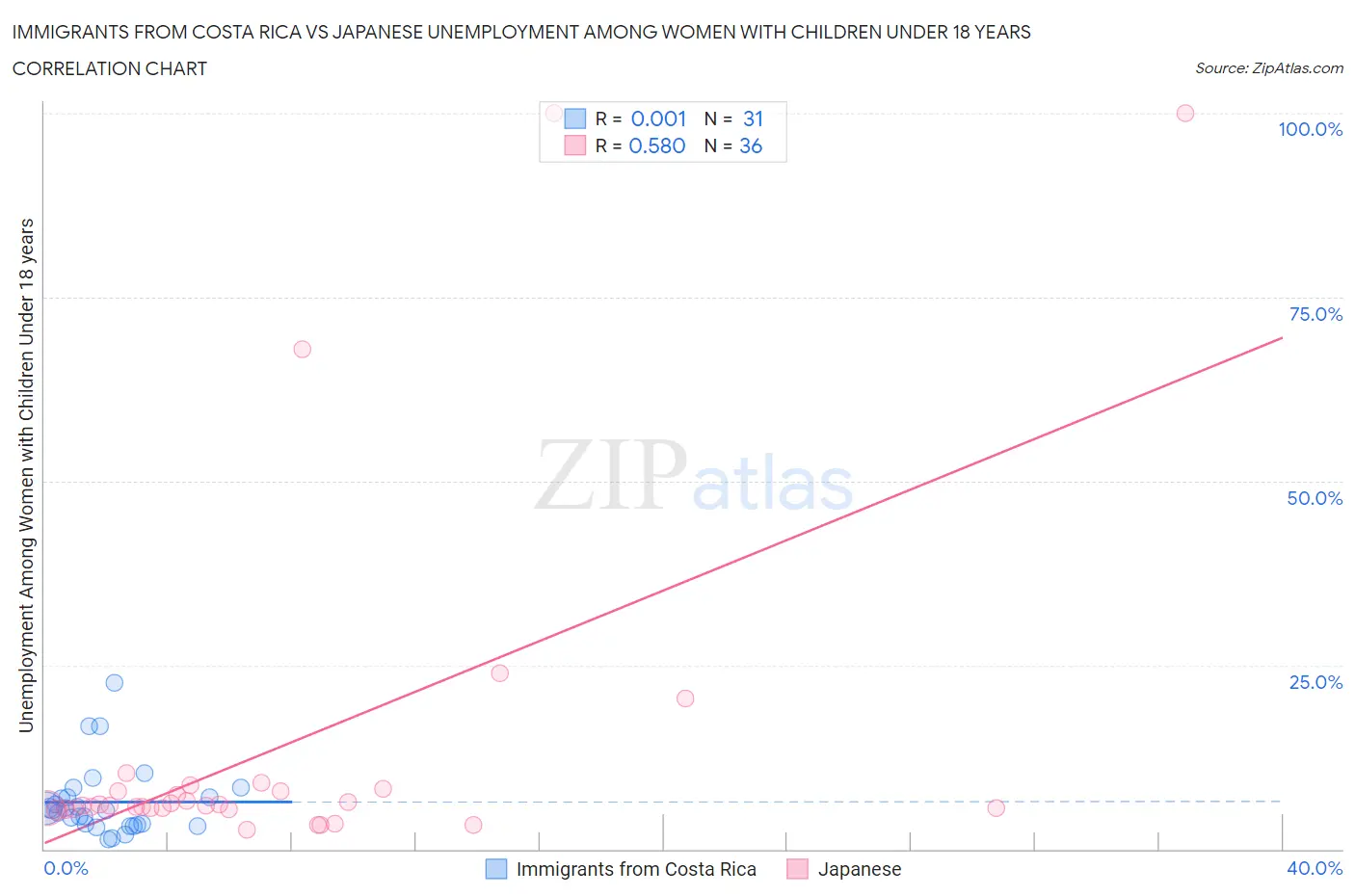Immigrants from Costa Rica vs Japanese Unemployment Among Women with Children Under 18 years
COMPARE
Immigrants from Costa Rica
Japanese
Unemployment Among Women with Children Under 18 years
Unemployment Among Women with Children Under 18 years Comparison
Immigrants from Costa Rica
Japanese
5.6%
UNEMPLOYMENT AMONG WOMEN WITH CHILDREN UNDER 18 YEARS
11.6/ 100
METRIC RATING
208th/ 347
METRIC RANK
5.7%
UNEMPLOYMENT AMONG WOMEN WITH CHILDREN UNDER 18 YEARS
8.7/ 100
METRIC RATING
214th/ 347
METRIC RANK
Immigrants from Costa Rica vs Japanese Unemployment Among Women with Children Under 18 years Correlation Chart
The statistical analysis conducted on geographies consisting of 201,252,028 people shows no correlation between the proportion of Immigrants from Costa Rica and unemployment rate among women with children under the age of 18 in the United States with a correlation coefficient (R) of 0.001 and weighted average of 5.6%. Similarly, the statistical analysis conducted on geographies consisting of 244,244,849 people shows a substantial positive correlation between the proportion of Japanese and unemployment rate among women with children under the age of 18 in the United States with a correlation coefficient (R) of 0.580 and weighted average of 5.7%, a difference of 0.54%.

Unemployment Among Women with Children Under 18 years Correlation Summary
| Measurement | Immigrants from Costa Rica | Japanese |
| Minimum | 1.3% | 2.6% |
| Maximum | 22.6% | 100.0% |
| Range | 21.3% | 97.4% |
| Mean | 6.4% | 13.8% |
| Median | 5.3% | 5.9% |
| Interquartile 25% (IQ1) | 3.3% | 5.5% |
| Interquartile 75% (IQ3) | 7.1% | 8.0% |
| Interquartile Range (IQR) | 3.8% | 2.6% |
| Standard Deviation (Sample) | 4.7% | 23.9% |
| Standard Deviation (Population) | 4.6% | 23.5% |
Demographics Similar to Immigrants from Costa Rica and Japanese by Unemployment Among Women with Children Under 18 years
In terms of unemployment among women with children under 18 years, the demographic groups most similar to Immigrants from Costa Rica are Immigrants from Western Asia (5.6%, a difference of 0.060%), Peruvian (5.6%, a difference of 0.080%), Nicaraguan (5.6%, a difference of 0.12%), Nonimmigrants (5.7%, a difference of 0.17%), and Panamanian (5.7%, a difference of 0.27%). Similarly, the demographic groups most similar to Japanese are American (5.7%, a difference of 0.040%), Immigrants from Uganda (5.7%, a difference of 0.20%), South American (5.7%, a difference of 0.25%), Panamanian (5.7%, a difference of 0.26%), and Immigrants from Peru (5.7%, a difference of 0.30%).
| Demographics | Rating | Rank | Unemployment Among Women with Children Under 18 years |
| Immigrants | Morocco | 17.9 /100 | #201 | Poor 5.6% |
| Immigrants | Micronesia | 17.1 /100 | #202 | Poor 5.6% |
| Portuguese | 15.9 /100 | #203 | Poor 5.6% |
| Israelis | 15.6 /100 | #204 | Poor 5.6% |
| Tsimshian | 15.2 /100 | #205 | Poor 5.6% |
| Nicaraguans | 12.3 /100 | #206 | Poor 5.6% |
| Peruvians | 12.1 /100 | #207 | Poor 5.6% |
| Immigrants | Costa Rica | 11.6 /100 | #208 | Poor 5.6% |
| Immigrants | Western Asia | 11.3 /100 | #209 | Poor 5.6% |
| Immigrants | Nonimmigrants | 10.6 /100 | #210 | Poor 5.7% |
| Panamanians | 10.1 /100 | #211 | Poor 5.7% |
| South Americans | 10.0 /100 | #212 | Poor 5.7% |
| Americans | 8.9 /100 | #213 | Tragic 5.7% |
| Japanese | 8.7 /100 | #214 | Tragic 5.7% |
| Immigrants | Uganda | 7.9 /100 | #215 | Tragic 5.7% |
| Immigrants | Peru | 7.4 /100 | #216 | Tragic 5.7% |
| Immigrants | Brazil | 7.1 /100 | #217 | Tragic 5.7% |
| Immigrants | Nicaragua | 7.0 /100 | #218 | Tragic 5.7% |
| Iroquois | 6.5 /100 | #219 | Tragic 5.7% |
| Immigrants | Fiji | 6.3 /100 | #220 | Tragic 5.7% |
| Pennsylvania Germans | 5.7 /100 | #221 | Tragic 5.7% |